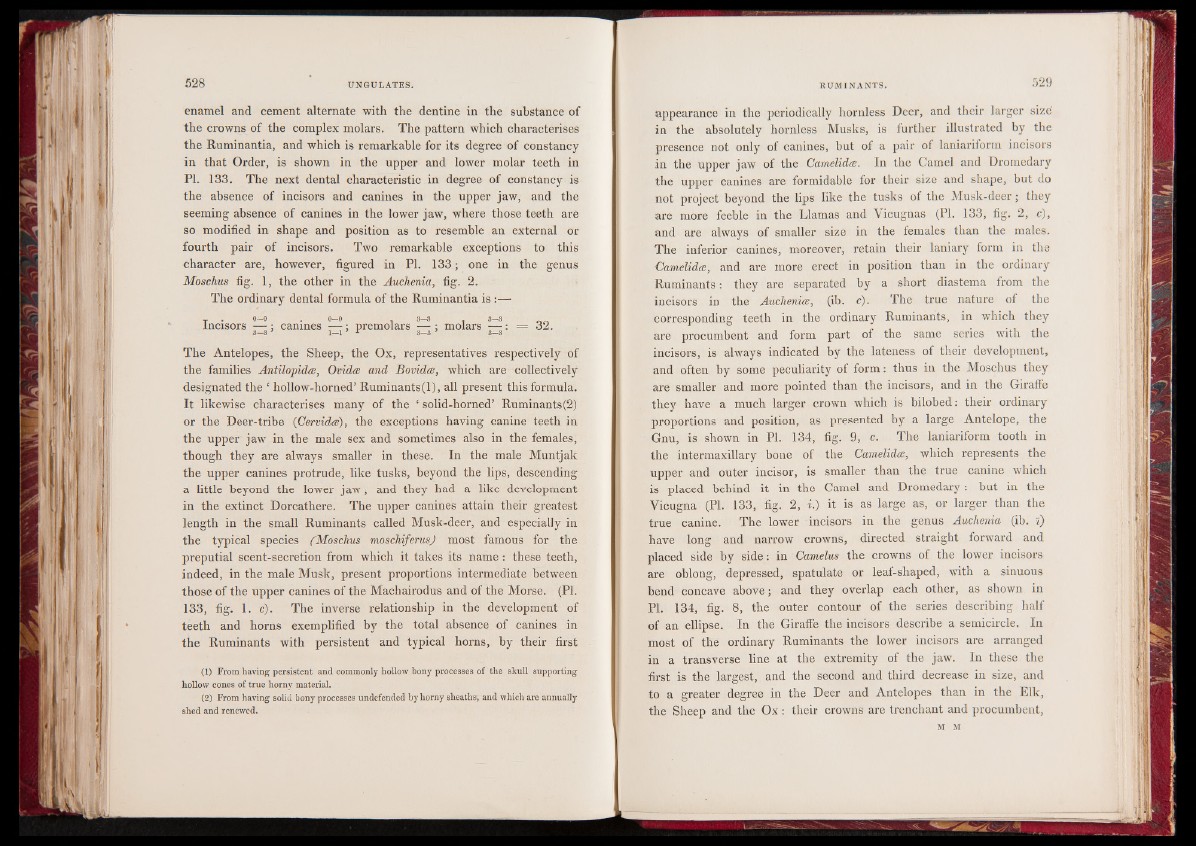
enamel and cement alternate with the dentine in the substance of
the crowns of the complex molars. The pattern which characterises
the Ruminantia, and which is remarkable for its degree of constancy
in that Order, is shown in the upper and lower molar teeth in
PI. 133. The next dental characteristic in degree of constancy is
the absence of incisors and canines in the upper jaw, and the
seeming absence of canines in the lower jaw, where those teeth are
so modified in shape and position as to resemble an external or
fourth pair of incisors. Two remarkable exceptions to this
character are, however, figured in PI. 133 ; one in the genus
Moschus fig. 1, the other in the Auchenia, fig. 2.
The ordinary dental formula of the Ruminantia is :—
Incisors — canines|8SS; premolars IS ; molars — : = 32.
The Antelopes, the Sheep, the Ox, representatives respectively of
the families Antïlopidæ, Ovidoe and Bovidoe, which are collectively
designated the 5 hollow-horned’ Ruminants(l), all present this formula.
It likewise characterises many of the ‘ solid-horned’ Ruminants (2)
or the Deer-trihe (Cervidé), the exceptions having canine teeth in
the upper jaw in the male sex and sometimes also in the females,
though they are always smaller in these. In the male Muntjak
the upper canines protrude, like tusks, beyond the lips, descending
a little beyond the lower jaw ; and they had a like development
in the extinct Dorcathere. The upper canines attain their greatest
length in the small Ruminants called Musk-deer, and especially in
the typical species ('Moschus moschiferusj most famous for the
preputial scent-secretion from which it takes its name : these teeth,
indeed, in the male Musk, present proportions intermediate between
those of the upper canines of the Machairodus and of the Morse. (PI.
133, fig. I: c). The inverse relationship in the development of
teeth and horns exemplified by the total absence of canines in
the Ruminants with persistent and typical horns, by their first
(1) From having persistent and commonly hollow bony processes of the skull supporting
hollow cones of true horny material.
(2) From having solid bony processes undefended by horny sheaths; and which are annually
shed and renewed.
appearance in the periodically hornless Deer, and their larger size
in the absolutely hornless Musks, is further illustrated by the
presence not only of canines, but of a pair of laniariform incisors
in the upper jaw of the Camelidce. In the Camel and Dromedary
the upper canines are formidable for their size and shape, but do
not project beyond the lips like the tusks of the Musk-deer; they
are more feeble in the Llamas and Vicugnas (PI. 133, fig. 2, c),
and are always of smaller size in the females than the males.
The inferior canines, moreover, retain their laniary form in the
Camelidee, and are more erect in position than in the ordinary
Ruminants: they are separated by a short diastema from the
incisors in the Auchenice, (ib. c). The true nature of the
corresponding teeth in the ordinary Ruminants, in which they
are procumbent and form part of the same series with the
incisors, is always indicated by the lateness of their development,
and often by some peculiarity of form: thus in the Moschus they
are smaller and more pointed than the incisors, and in the Giraffe
they have a much larger crown which is bilobed: their ordinary
proportions and position, as presented by a large Antelope, the
Gnu, is shown in PI. 134, fig. 9, c. The laniariform tooth in
the intermaxillary bone of the Camelidce, which represents the
upper and outer incisor, is smaller than the true canine which
is placed behind it in the Camel and Dromedary : but in the
Vicugna (PI. 133, fig. 2, i.) it is as large as, or larger than the
true canine. The lower incisors in the genus Auchenia (ib. i)
have long and narrow crowns, directed straight forward and
placed side by side: in Camelus the crowns of the lower incisors
are oblong, depressed, spatulate or leaf-shaped, with a sinuous
bend concave above; and they overlap each other, as shown in
PI. 134, fig. 8, the outer contour of the series describing half
of an ellipse. In the Giraffe the incisors describe a semicircle. In
most of the ordinary Ruminants the lower incisors are arranged
in a transverse line at the extremity of the jaw. In these the
first is the largest, and the second and third decrease in size, and
to a greater degree in the Deer and Antelopes than in the Elk,
the Sheep and the O x: their crowns are trenchant and procumbent,
M M